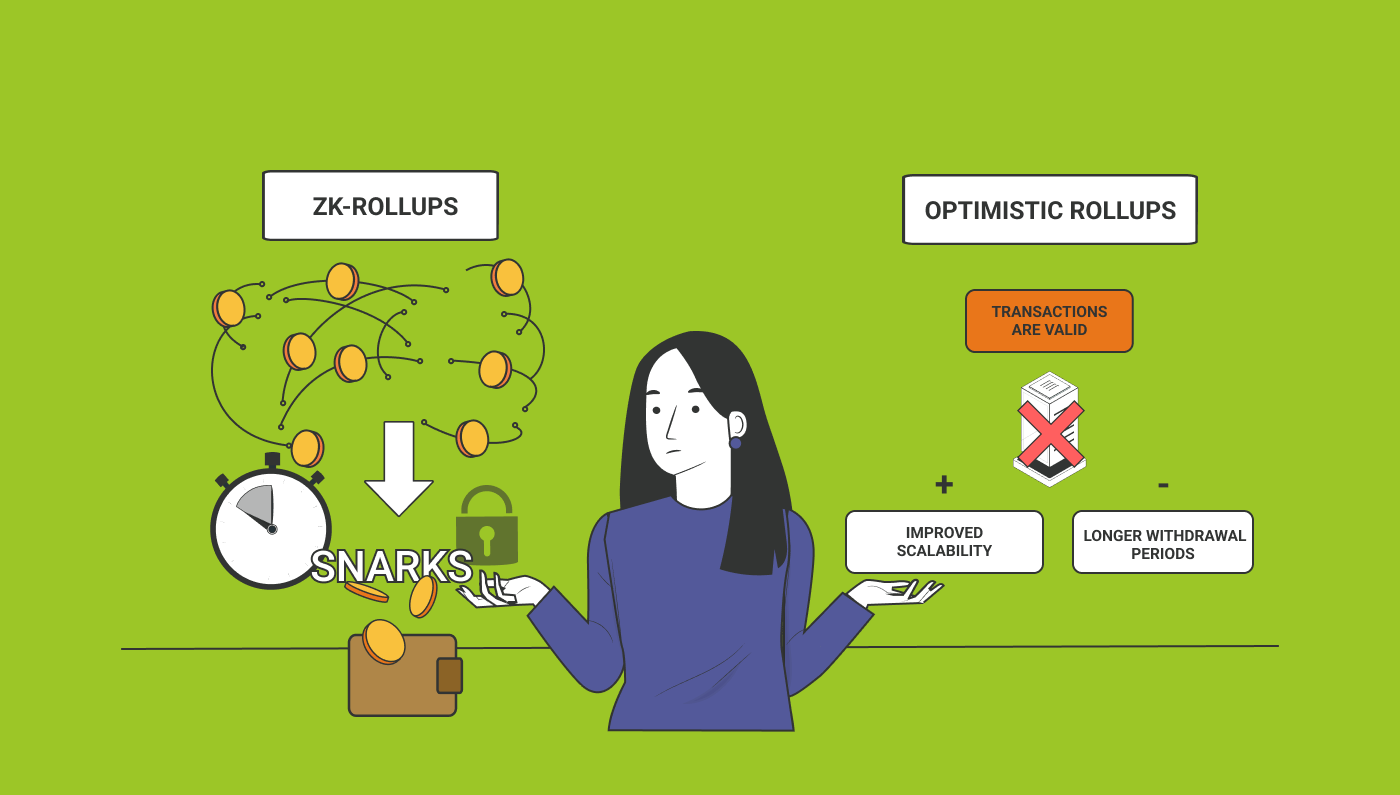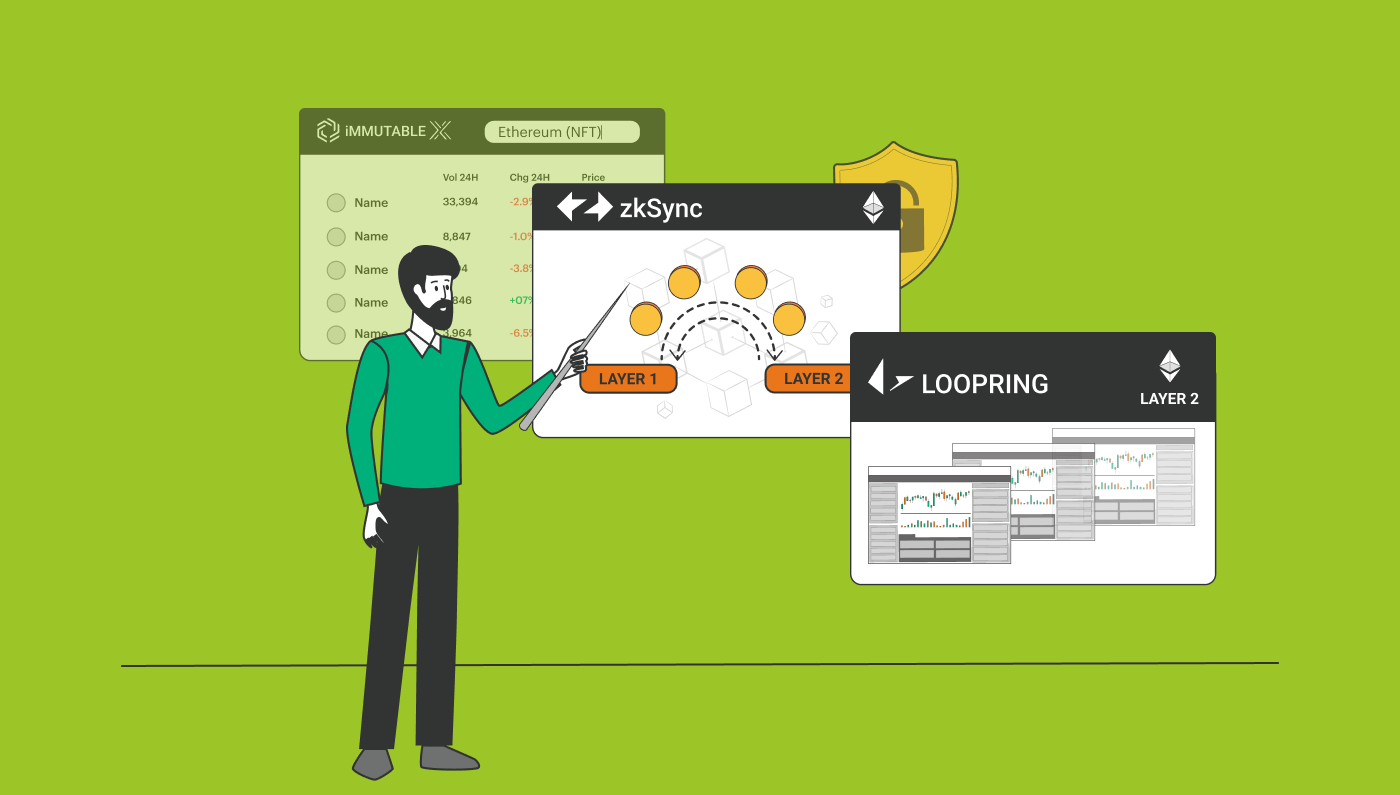ZK-Rollups Explained
New crypto trends are emerging all the time from non-fungible tokens (NFTs) to the metaverse. Smart investors who got in on the ground floor with any of these recent applications of blockchain technology have been well positioned to make exceptionally high gains.
One emerging trend that is currently gaining a great deal of attention is ZK-Rollups.
What are ZK-Rollups?

ZK-Rollups, short for Zero Knowledge Rollups are a type of smart contract that reduces the computing and storage resources needed to validate blocks. It does so by taking hundreds of transactions off the main blockchain. It then bundles them into a single transaction, before sending proof of validation back to the main blockchain.
ZK-Rollups reduce the amount of data in a transaction by means of cryptographic zero-knowledge proofs (ZKPs). In other words, a party can prove that it has knowledge or ownership of a specific asset without having to provide any information about what they know or have. This decreases the amount of data being sent through Ethereum’s main blockchain (Layer 1).
So, what are ZK-Rollups doing that is so valuable? Basically, they allow for quicker and cheaper transactions. They can scale the Ethereum network as a result of being able to process hundreds of transfers off-chain, rolling them up into one transaction and then sending a validity proof known as a Succinct Non-interactive Argument of Knowledge (SNARK) back to the main chain as authentication. Instantly verifiable, SNARKS can dramatically reduce transaction fees, while significantly improving throughput and scalability.
ZK-Rollups Vs. Optimistic Rollups

ZK rollups generate cryptographic proofs, and each bundle of transactions has its own validity proof, which is submitted to the main chain. However, Optimistic Rollups work on the assumption that all transactions are valid and submit bundles of transactions without performing any computation.
On the plus side not performing computation by default leads to improved scalability. However, the downside is that a challenge period is required which translates to longer withdrawal periods. The challenge period is a time during which the legitimacy of data in a batch of transactions can be disputed. If fraud is identified, then a fraud proof is executed that performs the computation utilizing Layer 1 data. Since sequencers are required to stake ETH, they are deterred from submitting fraudulent transactions, as this would mean their stake would be cut.
It’s also worth noting that Optimistic Rollups can provide the properties that users want, at lower cost, because of the very high off-chain costs of constructing ZK proofs. Optimistic Rollups are also capable of executing smart contracts, whereas ZK rollups are mostly limited to simple transactions. However, a ZK Rollup has the advantage of being faster than an Optimistic Rollup since it is much lighter on Layer 2 as the validation occurs on the mainchain and not on the sidechain.
The Main ZK-Rollup Platforms

To get a better understanding of how ZK-Rollup platforms function let’s examine a few of the leading players in this arena.
Immutable X (IMX)
The Immutable X platform is a Layer 2 scaling solution, which is used for trading Ethereum non-fungible tokens (NFTs) for gaming. It utilizes ZK-Rollups to provide instant trade confirmation, with zero gas fees for NFT trading and performs over 9,000 transactions per second. Immutable X enables users to set their own trading fees and any NFT created or traded on Immutable X is totally carbon neutral.
zkSync
zkSync is another Ethereum network, Layer 2, scaling solution that is uses ZK-Rollup technology to offer lower-cost, quicker transactions. It processes transactions off-chain at a speed of 2,000+ transactions per second, without compromising security, and offers exceptionally low gas fees equal to 1% of Ethereum gas. Secured by the main Ethereum blockchain, zkSync allows for the easy, frictionless transfer of crypto between Layer 1 and Layer 2 at any time with no delays.
Loopring (LRC)
One of the better known ZK Rollup platforms is Loopring (LRC), which offers a Layer 2 solution for the Ethereum network, enabling more cost-effective transactions and faster settlements. The idea behind the platform is that it will enable the user to utilize zero knowledge proofs to build their own non-custodial order book-based crypto exchange. In contrast to other decentralized exchanges, Loopring leverages ZK-Rollups to allow exchanges to validate blocks off-chain. By completing computations in this way, less transactions are being sent to the Ethereum network allowing for faster and cheaper trades.
The Advantages and Disadvantages of ZK-Rollups

ZK-Rollups offer a vast number of benefits. Firstly, there is faster transaction finality, the time required to receive confirmation that a blockchain transaction is final and won’t be altered or cancelled. It also provides significantly higher throughput and scalability, since very little data is required for each transaction, meaning faster and more efficient processing as minimal information is getting communicated between nodes. There are also faster withdrawal times as validity proofs certify transaction data as well as cheaper transaction fees, since gas is shared by users whose transactions are rolled up and bundled together. Finally, there is the fact that since ZK-Rollups are “zero knowledge”, data retrieval only requires the validity proof stored on Layer 1, and not every piece of transactional data. This means that they can remain decentralized, and incredibly secure.
Unfortunately, however, there are also some drawbacks to the use of ZK-Rollups at their present stage of development. Firstly, they require complex validity proofing, a time-consuming, difficult process involving complicated mathematical computations that currently limit their functionality to very simple, basic transactions. Moreover, in contrast to other scaling solutions for Layer 2, ZK-Rollups are not presently able to support smart contract execution.
Here at ArbiSmart, we are at the forefront of current crypto trends and in 2022, we will be introducing a series of secure EU authorized crypto services, powered by our native token RBIS. Our expanding crypto ecosystem is designed to take advantage of the most innovative applications of blockchain technology and in the next quarter alone, we are introducing a decentralized yield farming program, an NFT marketplace, and the ArbiSmart interest-generating wallet, with more utilities to come in the second half of the year.
To explore a wide range of crypto and blockchain trends, or to learn about RBIS and a range of other crypto assets, check out the ArbiSmart blog.